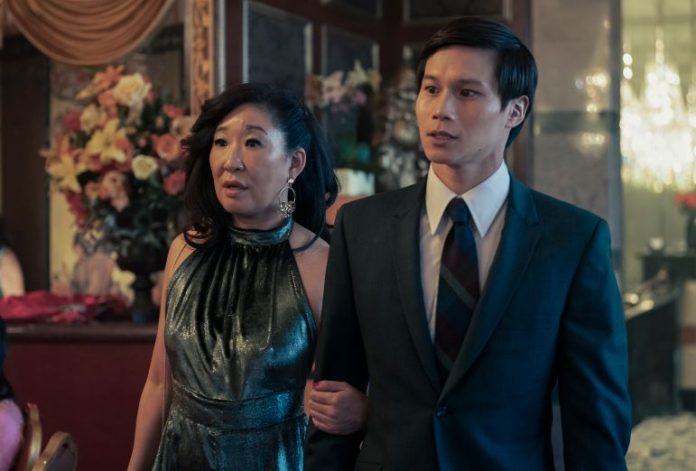HBO’s will release the fifth of six episodes of its critically acclaimed The Sympathizer this Sunday.
The story told is one many of the actors and crew lived in real life. Many agreed to speak about what being cast in the show meant to them. HBO agreed to give AsAmNews the first look at the video piece.
“Usually when the war ends, the show or movie ends. But for the Vietnamese refugees on The Sympathizer, that’s when the real story begins,” said actor Fred Nguyen Khan who played Bon.
Every detail from the wardrobe to the props to the set were designed to be authentic. The crew even brought in more Hennessy to stock the store shelf at the liquor store because the brand is popular among Vietnamese.
As one person said, authenicity is important.
“They just put so much detail and attention into them,” Vy Le who portrayed Lana said.
“This is the first time we get to tell our story through the Vietnamese perspective,” said Duy Nguyen who was cast as Man.
“A lot of the cast have a real life parallel to the script,” said Ky Duyen who played Madame.
The Sympathizer stars Hoa Xuande who is actually from Australia. The director tasked him with speaking English with an American accent and to talk in Vietnamese, a language he isn’t proficient in. Coaches worked with him for days to make sure everything he spoke sounded authentic.
“A lot of sleepless nights,” he joked.
Sieu Nguyen, the HBO Producer for the featurette, recently agreed to participate in a question and answer.
How did you get into the entertainment industry?
I have always loved storytelling and had wanted to work in the entertainment industry since my high school days in Vietnam. I watched a lot of Hollywood films and TV shows back then and always felt like they were portals into a different world.
My official “foot in the door” was thus my first job as a Production Associate at Paramount. I started out by doing assistant editor’s work: tagging promos, logging footage, synching interviews, digitalizing tapes, and transporting drives to trailer houses around the city. Having always wanted to create my own work, I stayed in the office after hours to brainstorm, produce and edit short videos, learning the craft while turning my ideas to reality. When I pitched those pieces to my Creative Director at the time, she loved them and officially offered me producing and editing opportunities. I learned from this experience that taking initiatives to do what you love goes a long way.
· What’s unique about your personal story when it comes to working in entertainment?
I was born and raised in Vietnam. When I moved to the United States at 17, I was met with various barriers since English isn’t my first language and the cultures are vastly different. Even when I started working and was confident in my language skills, I still didn’t fully think I “fit in” with the culture, which is tightly interwoven into every piece of entertainment. I only laughed at some of the jokes and continuously got anxious about making typos in emails.
In my work, I learned to tap into something universal: feelings. Joy, hope and the desire to belong transcend cultural boundaries. My goal with every creative I produce is then to embrace and express those feelings, making the story relatable to people from all backgrounds.
The more I navigated the entertainment industry in the United States, the more I also understood “fitting in” isn’t always the goal. This is an industry that values diversity: a different perspective isn’t a drawback, but a strength. Over the years, I learned to harness my own voice and produce creatives that reflect my personal sensibilities. My Creative Director at HBO, John Wilhelmy, once said, “Create something that first and foremost speaks to you.” That is one of the best pieces of advice I have ever received and a philosophy I now live by.
· What did working on the campaign for The Sympathizer mean to you?
Working on The Sympathizer has been a tremendous opportunity. Having a show where my mother tongue is spoken and my culture represented air on HBO is something I have never dreamed of, so I was excited to produce content for its marketing campaign. When I first watched the show, it brought me to tears hearing dialogues in Vietnamese. There’s something ethereal about hearing your first language – it has the power to touch your soul in a way no others can.
In my latest featurette for The Sympathizer, titled A Vietnamese Story, I explore the casting of Vietnamese actors, the use of Vietnamese language, how the production design evokes Vietnamese architecture and the significance of costumes in the show. I want to spotlight the importance of authenticity, which was a priority for the creators of The Sympathizer. \
I built a section in this piece around the “áo dài,” a traditional Vietnamese dress that many of our characters wear. I was touched by costume designer Danny Glicker’s story about sourcing the fabric directly from my homeland, Vietnam. This is also a garment that is near and dear to my heart. I wrote an essay on the “áo dài” in high school and a research paper about it in college, the latter of which I presented at the 2015 New York Conference on Asian Studies. Exploring it in this featurette feels like the third instalment of a personal trilogy that celebrates this garment. (I have a photo of me presenting this paper next to a real áo dài, if needed.)
Even when living in the United States, I never forgot I am from Vietnam. I have always wanted to bring my culture to the world, and this is the perfect opportunity to do so. I hope this featurette shows the richness of the Vietnamese language, the intricacies of Vietnamese clothing, the beauty of Vietnamese landscapes, and the talent of Vietnamese people. I hope it captures my love for Vietnam and for universal storytelling.
· Do you have any advice for AAPI people trying to break into the industry?
My advice would be to embrace your own voice and never stop telling your stories. There are so many untold AAPI stories in the media and we need to make our voices heard. The way AAPI people navigate this world, which is not always kind to our community, is brave, brilliant, and beautiful. These stories deserve a platform and have the power to inspire. The representation of AAPI cultures does not stop at “Crazy Rich Asians,” “Everything Everywhere All At Once” or “The Sympathizer.” This is just the beginning.
· Anything else you’d like to add?
I am just grateful for the opportunity to share this story. Being a Vietnamese person in the HBO Marketing A/V team working on this project is a privilege. I feel very proud to be part of the AAPI and Vietnamese communities and to create art that celebrate our culture.
AsAmNews is published by the non-profit, Asian American Media Inc.
Happy Lunar New Year. Help us get over the top. We are now 91% of our goal of meeting our $5,000 matching grant challenge with less than 4 full days to go. Every donation will be matched dollar for dollar through Sunday for up to the remaining $500 from our challenge. All donations will go toward fully funding an editor position at AsAmNews and to support our reporting. You can make your tax-deductible donations here via credit card, debit card, Apple Pay, Google Pay, PayPal and Venmo. Stock donations and donations via DAFs are also welcomed.
Please also follow us on Instagram, TikTok, Facebook, YouTube and X.


